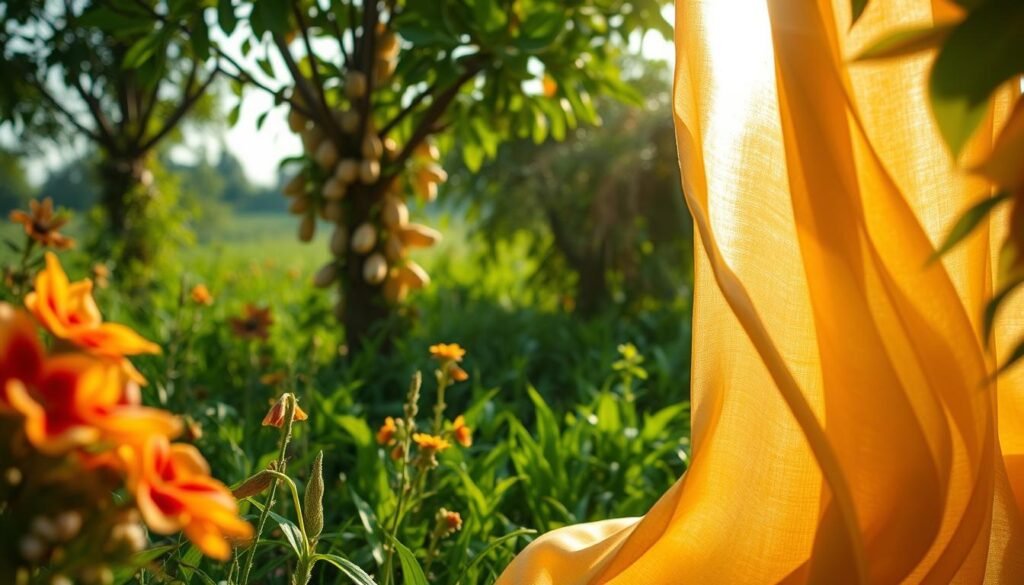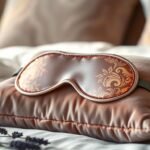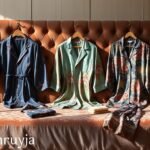Did you know silk pillowcases can help reduce skin irritation and sleep lines? Silk fabrics are becoming more popular, not just for fashion but also for health and beauty. They’re changing beauty trends, from skincare to better sleep.
In today’s world, people are looking for silk fabrics for their many benefits. They’re not just beautiful; they also improve health. Let’s dive into how silk is changing health routines and beauty practices.
Key Takeaways
- Silk fabrics offer significant health benefits for skin and hair.
- Sleep quality can be enhanced by using silk pillowcases.
- Silk is hypoallergenic, making it suitable for sensitive skin.
- Increased popularity of silk in beauty routines has been driven by social media.
- Silk materials help in reducing friction, promoting skin and hair health.
- Custom silk products, such as those available at Tianruiyi, further enhance the luxurious experience.
The Luxurious Appeal of Silk Fabrics
Silk has a unique and luxurious silk texture that captivates both fashion enthusiasts and beauty aficionados. This exceptional fabric stands as a testament to timeless elegance, making it a favorite in silk fashion. The smooth finish and lightweight feel of silk materials enhance any outfit, allowing for effortless sophistication through various style choices.
Despite its delicate appearance, the strength of silk is remarkable. It ranks among the strongest natural fibers, ensuring that garments crafted from silk can endure significant wear over time. With proper care, items made of silk can remain a staple in one’s wardrobe for many years, representing a wise investment.
Silk’s versatility allows it to be a part of various trending styles and collections. Designers often embrace the elegance of silk, creating pieces like luxurious evening gowns, elegant blouses, and stunning accessories. This adaptability extends to home textiles, like exquisite pillows and draperies, that elevate interior aesthetics.
Also, silk’s unique properties enhance its luxurious appeal. It naturally regulates temperature, providing comfort in different weather conditions. The luxurious shine and rich colors of mulberry silk can transform any ordinary look into a statement of refined elegance.
Health and Beauty Trends for Silk Fabrics
Silk is now key in today’s beauty and personal care. It’s great for skin and hair, making it a favorite among beauty lovers. Silk’s special qualities make it a big part of modern beauty routines, as people look for natural and effective skincare.
Understanding the Benefits of Silk for Skin and Hair
The silk benefits for skin are clear. It keeps skin and hair oils better than cotton. This helps keep skin moist and elastic, making fine lines less visible. For hair health with silk, its smooth surface reduces hair breakage and boosts shine. Hair experts say silk helps prevent split ends and keeps hair moist.
The Role of Silk in Modern Beauty Routines
In modern beauty routines, silk in beauty products are becoming more popular. Stars like Kim Kardashian and Gisele Bündchen use silk pillowcases for their beauty benefits. Silk’s natural proteins help hydrate and repair skin, making it look better.
Also, silk is good for sensitive skin and fights germs. Its anti-aging effects come from its natural makeup, which includes proteins like sericin and fibroin.
| Silk Product | Benefits |
|---|---|
| Pillowcases | Retain moisture; reduce skin creases |
| Skincare Silk Products | Hydration; anti-aging; improves skin texture |
| Silk Scarves | Protect hair from damage; promote hair growth |
| Silk Hair Accessories | Minimize friction; reduce split ends |
Silk’s Moisturizing Properties
Silk fabrics are not just luxurious; they’re also great for your skin. The silk properties help keep your skin hydrated and improve its look. Silk is good at pulling moisture away from your skin, which helps keep it moist.
This is really helpful for people with dry skin. It keeps your skin hydrated all night long.
How Silk Helps Maintain Skin Hydration
Silk has fibers that are similar to those in human skin. This makes it great at keeping moisture in. Unlike cotton, silk doesn’t soak up moisture. So, your skin creams and oils stay on longer.
Many doctors suggest using silk pillowcases for dry or sensitive skin. They help create a caring sleep environment. They also make your skincare routine work better.
The Impact of Silk on Complexion and Aging
Silk also helps fight skin aging. It reduces friction while you sleep, which means fewer wrinkles. Using silk regularly can make your skin look smoother and younger.
People often notice their skin looks better, even if they sleep on their side. Silk’s soft surface is good for your skin’s health.
| Silk Benefits | Description |
|---|---|
| Moisture Retention | Silk helps preserve essential oils and moisture, maintaining skin hydration. |
| Reduces Friction | Minimizing friction helps decrease wrinkles and maintains a youthful appearance. |
| Skin-Friendly | Hypoallergenic and gentle on sensitive skin, reducing irritation and enhacing complexion. |
| Temperature Regulation | Allows for air circulation, keeping users comfortable and contributing to skin health. |
Silk Pillowcases and Hair Health
Silk pillowcases are changing the game in hair care. They offer a smooth surface for hair, reducing damage. This makes hair look healthy and vibrant.
Reducing Hair Breakage with Silk
Silk pillowcases are great at reducing hair breakage. Traditional pillowcases can cause hair damage, leading to split ends. Silk pillowcases, on the other hand, are smooth, allowing hair to move freely.
This is key for curly or fragile hair. It helps keep the cuticle layer intact. Using silk pillowcases means less tangled hair in the morning.
The Advantage of Silk over Other Materials
Silk is better than cotton and satin for hair care. Satin may help with hair maintenance, but silk is more breathable and retains moisture. This makes silk pillowcases better for hair health.
They keep hair hydrated and regulate temperature. This ensures a comfortable sleep. Investing in silk pillowcases offers many benefits, including being naturally hypoallergenic. This reduces irritation and improves skin and hair health.
| Feature | Silk Pillowcases | Cotton Pillowcases | Satin Pillowcases |
|---|---|---|---|
| Friction | Low | High | Moderate |
| Moisture Retention | Excellent | Poor | Fair |
| Temperature Regulation | Superior | Poor | Good |
| Hypoallergenic | Yes | Depends on fibers | No |
Silk in Skin Care Products
Silk in skincare has become very popular. Beauty products with silk are now common in many routines. They offer benefits that make products work better.
Silk proteins come from silkworm cocoons. They have antioxidants and anti-inflammatory properties. This makes them good for soothing and improving skin.
Silk proteins help with hydration and reduce fine lines. They also make skin smoother. Amino acids in silk help repair cells and keep skin hydrated.
Silk is also good for the environment. It’s biodegradable and compostable. Even though it’s more expensive, its benefits make it worth it for high-end skincare.
| Property | Silk Proteins | Synthetic Peptides |
|---|---|---|
| Origin | Natural (from silkworm cocoons) | Artificial (laboratory-derived) |
| Compatibility | Biocompatible, hypoallergenic | May cause irritation |
| Cost | Higher manufacturing cost | Generally lower manufacturing cost |
| Skin Benefits | Hydration, elasticity, soothing | Variable; potentially irritating |
Adding silk proteins to skincare products boosts their performance. It meets the demand for natural and effective beauty. Silk’s lasting appeal is changing skincare, making it a key ingredient in today’s beauty products.
Silk Fabrics: A Sustainable Choice
The talk about sustainable fashion now includes silk fabrics. They are a green option compared to synthetic materials. The silk production process has changed, focusing on sustainable silk that’s better for the environment. It’s also important to make sure silk is made ethically.
The Eco-Friendly Aspects of Silk Production
The silk industry has both good and bad sides when it comes to the environment. Traditional silk making uses a lot of energy and has faced criticism for labor issues. For example, Human Rights Watch has spoken out about child labor in some places.
But, there are better ways to make silk. Peace silk and bamboo silk are made without harming animals and are better for the planet.
- Peace silk, or Ahimsa silk, is made without harming silkworms.
- Bamboo silk is made from bamboo fibers and is light and eco-friendly.
- Orange Fiber Fabric is made from plant waste and is a new, sustainable option.
Consumer Preference for Natural Ingredients in Beauty
More people want natural ingredients in their skincare. They are looking for beauty products that are good for the planet. Silk is becoming popular because it feels luxurious and is good for the skin.
| Silk Type | Sustainability Features | Popular Usage |
|---|---|---|
| Mulberry Silk | Biodegradable, durable with proper care | Luxury goods, bedding, apparel |
| Peace Silk | Cruelty-free, ethical production | High fashion collections |
| Bamboo Silk | Renewable resource, low impact | Lightweight clothing, accessories |
| Orange Fiber | Recycling of agricultural waste | Fashion apparel |

There’s a big change in what people want in beauty and fashion. They want products that are good for the planet and their skin. Brands that use sustainable silk are meeting this demand and appealing to customers who care about the environment.
Innovations in Silk Fabric Technology
The world of silk fabric technology has grown a lot. It now includes new advancements that improve health and beauty. Silk protein technology is a big part of this, making silk proteins useful in many products. This shows how silk can be good for our skin and hair.
Advancements in Silk Protein for Health and Beauty
New ways to get and use silk protein are changing how we see silk in beauty items. The market, worth about USD 921.43 million in 2023, is growing. It’s expected to hit over USD 1.61 billion by 2032, showing silk’s health benefits are more valued.
- Biocompatibility: Silk protein works well with human skin, perfect for sensitive skin products.
- Fibroin Innovation: Fibroin, the main silk protein, made up USD 543.33 million of the market in 2023. It’s expected to grow more.
- Moisturizing Properties: Silk protein helps keep skin hydrated and fights aging in beauty products.
Companies like AMSilk GmbH and Evolved by Nature are leading in silk protein tech. They’re making vegan silk protein, which is popular. This shows a trend towards better, eco-friendly beauty products.
| Year | Market Value (USD millions) | Growth Rate (CAGR) |
|---|---|---|
| 2023 | 921.43 | N/A |
| 2032 | 1610.00 | 6.2% |
These changes in silk protein tech mark a new era for silk. It’s not just about luxury anymore. It’s about making our skin and hair better. The future looks bright with more eco-friendly silk products on the way.
Popular Silk Products in the Beauty Industry
The beauty world loves silk for its beauty and health perks. Scarves and hair wraps are now key in many beauty routines. They add luxury and help with hair and skin, making them a favorite among beauty lovers.
Silk Scarves, Hair Accessories, and more
Silk is big for hair care, with items like scrunchies and wraps. They keep hair moist and prevent breakage. Brands like Brooklinen and Grace Eleyae make high-quality silk items. They focus on design and quality, making silk a part of daily beauty.
Exploring Top Silk Brands
Looking for the best silk? LilySilk, Slip, and Casaluna are top choices. They make silk items that are both beautiful and functional. Their products, like pillowcases and hair care, improve skin and hair health.
| Product Type | Benefits | Top Brands |
|---|---|---|
| Silk Pillowcases | Minimizes hair breakage, enhances skin hydration | LilySilk, Slip |
| Silk Scarves | Versatile fashion statement, protects hair | Brooklinen, Grace Eleyae |
| Silk Scrunchies | Gentle on hair, prevents damage | Slip |
| Silk Hair Wraps | Reduces frizz, retains moisture | Grace Eleyae, Casaluna |
The beauty world loves silk, and it’s here to stay. It’s a key part of beauty and wellness routines.
Enhancing Sleep Quality with Silk
Silk and sleep are closely linked for better sleep quality. Silk fabric’s unique properties help you sleep well. It’s smooth, which means less friction with your skin and hair. This prevents sleep lines and hair breakage.
The silk benefits for sleep don’t stop there. It also keeps your body temperature just right. This way, you stay cozy without getting too hot.
Silk pillowcases, made from 100% pure mulberry silk, are very effective. They keep your hair and skin oils in, helping with moisture all night. Silk doesn’t soak up moisture like cotton does. So, your skin and hair products stay effective.
People with delicate or mature skin find silk great. It’s also good for those who want smoother, more hydrated skin.
Silk is also breathable and wicks away moisture. This makes you feel more rested when you wake up. Silk doesn’t have silicones or dyes, so it’s less likely to irritate your skin. This makes it perfect for sensitive skin.
For those who want something eco-friendly, bamboo silk is a great choice. It’s naturally antibacterial and good for oily or acne-prone skin.

Switching to silk pillowcases brings many silk benefits for sleep. You’ll enjoy better comfort and skin health. Adding silk to your sleep routine can make your sleep more refreshing. It’s why many love silk and sleep together.
Silk: A Hypoallergenic Option
Silk is a top pick for those with sensitive skin. It’s known for being hypoallergenic, which means it doesn’t cause skin irritation. This makes it great for people with allergies or skin issues.
The natural fibers in silk also fight off dust mites and mold. This makes silk a healthier option than many other fabrics.
Benefits for Sensitive Skin Types
Using silk for bedding, like pillowcases, is very beneficial. The smooth surface helps prevent wrinkles and sleep lines. It also keeps your skin moist, which is key for a youthful look.
Silk is also good for your hair. It reduces frizz and breakage, keeping your hair healthy and shiny. People with sensitive skin love silk because it keeps allergens like dust mites away. It’s also gentle on skin conditions like eczema or dermatitis, providing much-needed moisture.
Historical Significance of Silk in Fashion and Beauty
Silk is deeply rooted in history, known for its luxurious feel and beauty. It traveled from China to northern Europe over a thousand years ago, covering 10,000 kilometers. Silk was more than just fabric; it was a sign of power and wealth.
In 1 BCE, China gave 30,000 bolts of silk and over 7,600 kilograms of silk floss to invaders. This showed silk’s value beyond money. Diocletian’s Edict of Maximum Prices showed that one pound of raw silk was as expensive as a smith’s wages for nine years.
By the 9th to 10th centuries, Baghdad became a major textile center. Thousands of artisans worked on silk and cotton. Adud al-Dawla gave 500 silk garments, showing the power of ‘silken diplomacy.’
The Abbasid dynasty helped grow complex patterns and techniques in silk. This made silk even more important in fashion history.
Characters like Lady Hsi Ling Shih became symbols of silk fashion. The oldest silk fabric pieces date back to 3630 BCE. The 10th century saw a rise in textile trade in West Africa.
Silk’s charm lasted through the ages, influencing famous people like Grace Kelly and Audrey Hepburn. They loved silk scarves. Today, silk is a key part of fashion, showing elegance and style in many cultures.
Current Trends in Silk Fashion
Today, silk is back in a big way, making fashion more elegant and sophisticated. Designers are now using silk in new ways, making it perfect for any event. Its softness, breathability, and luxurious feel make it a favorite in both high-end fashion and everyday clothes.
How Silk is Reshaping Modern Fashion Choices
The modern use of silk in fashion is all about bold looks and statement pieces. Silk dresses, tops, and accessories are now must-haves. They add a touch of class to any outfit, making it stylish and comfortable.
Designers are even adding silk to casual clothes, changing the game. This makes fashion more flexible and fun. For example, silk fashion updates now focus on making clothes that fit your personal style.
Silk is also becoming more eco-friendly. It’s a natural choice for those who care about the planet and quality. Brands that focus on ethical production make silk even more appealing, keeping it a top choice in fashion.
| Silk Characteristics | Benefits |
|---|---|
| Softness | Gentle on skin and hair |
| Breathability | Regulates temperature for comfort |
| Durability | Long-lasting, with proper care |
| Hypoallergenic | Ideal for sensitive skin |
| Luxurious Feel | Elevates style effortlessly |
Conclusion
Silk fabrics in health and beauty are a mix of luxury and usefulness. They make us look good and feel good too. Silk has natural proteins that keep our skin and hair healthy.
People are choosing silk because of its special qualities and eco-friendly making. The future of silk in beauty looks bright. It can even help us sleep better and is good for sensitive skin.
Silk will keep being popular as beauty trends change. It’s not just pretty; it’s also good for us and the planet. Silk is shaping the future of beauty in a world that cares about the environment.
FAQ
What are the health benefits of silk fabrics?
Silk fabrics are great for your skin and hair. They help keep them hydrated and reduce signs of aging. They’re also hypoallergenic, making them good for sensitive skin.
The smooth texture of silk reduces friction. This helps keep your skin and hair healthy by preventing breakage and irritation.
How does silk enhance beauty routines?
Silk keeps moisture in and prevents product loss. For example, silk pillowcases help keep your skin elastic and reduce fine lines. They also make your hair shiny and healthy.
Are silk fabrics a sustainable choice?
Yes, silk is more sustainable than synthetic fabrics. It’s biodegradable and has a lower environmental impact when sourced ethically. This meets the demand for eco-friendly fashion.
How do silk products contribute to better sleep quality?
Silk products, like pillowcases and sleep masks, improve sleep. They regulate body temperature and reduce skin friction. This makes sleep more comfortable and reduces sleep lines.
What types of silk products are popular in the beauty industry?
Popular silk products include pillowcases, hair accessories, scarves, and luxury bedding. Brands like LilySilk, Slip, and Casaluna offer high-quality options. They enhance both looks and health benefits.
Can silk help with specific skin conditions?
Yes, silk is good for sensitive skin. It resists dust mites and mold, which can irritate skin. Dermatologists often recommend silk for skin allergies.
What innovations are currently shaping silk fabric technology?
New silk protein technologies are improving its use in skincare and haircare. Research is exploring its moisturizing and anti-aging properties. This makes silk more compatible for cosmetics and medicine.
How does silk compare to other materials like cotton in terms of hair health?
Silk is better for hair than cotton. Its smooth texture reduces hair breakage and frizz. Silk also keeps hair hydrated, unlike cotton.
Why is silk becoming a preferred fabric in modern fashion?
Silk is loved for its luxurious feel and versatility. It’s timeless and elegant. Designers use silk to create stylish, sophisticated pieces.




